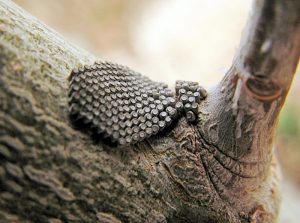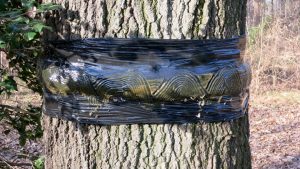Cankerworms, also known as inchworms or loopers, are devastating pests that commonly infest shade trees such as beech, oaks, maples, apple tree, black cherry, birch, basswood, elm, and many others. The larvae feed on the new leaves, thereby causing major defoliation, which may lead to branch dieback, infection, and even death of the host trees. Early identification can help you control their infestation.
If you notice shot holes on the young leaves, most likely, your trees have been infested. Here are some helpful tips on how to kill cankerworms and save your trees:
Kill Cankerworm Eggs
Killing cankerworm eggs is perhaps the most effective way of preventing the devastation that could be caused by them. Look for compact, flower-pot shaped egg clusters on branches and twigs of the plants and spray them with dormant horticultural oil mixture. The best time to spray the trees is late winter when the temperature is not below 40 degrees. The spraying process could be risky as you will have to climb up the tree to locate the eggs and spray them. Further, horticultural oils are not suitable for all trees and have to be used in a specific combination. Read the product label carefully before using.
Use a Spray Such as Bacillus Thuringiensis (BT)
Spraying is also effective when the larvae have emerged and have started feeding on the leaves. There are several organic sprays that you can use, but Bacillus Thuringiensis (BT) is the safest and most effective options. BT is a naturally organic bacterium that has insecticidal properties but is totally safe for pets and beneficial garden organisms. The best time to spray BT is when the leaves are unfolding or expanding, which happens in May. The larvae would be less than 13 mm at that time and can be controlled by spraying BT. If larvae have grown larger than 13 mm, BT may not give you the desired results.
Read how to kill cankerworms in PDF format
Use Sticky Bands
If you are wondering how to kill cankerworms without using any insecticide, try sticky bands. They are burlap or plastic bands coated with a sticky substance (preferably tanglefoot) on the upper side. These bands are effective during the fall and spring season when the fully grown adults come out of the soil to lay eggs. Tie them tightly around the bark of the trees at 4-5 foot high from the ground. When you band the trees during the fall season, you will disallow the adult female cankerworm to crawl up the trees to lay eggs. They will get caught in the sticky substance and won’t be able to lay eggs. You can then collect them in a jar of soapy water and keep them there until they have died. If the band is not tied tightly, filling up the crevices, the females will find their way to escape from the trap. Despite this limitation of the banding process, it still helps a lot in controlling the cankerworm population.
Use Natural Predators
Cankerworms have a lot of natural predators that can help control their population. Ground beetles and ants love to relish on the tiny larvae that come down to pupate in the soil. Unlike other caterpillars, the larvae of cankerworms are not hairy and therefore, birds too feed on them freely. Some wasps such as Telenomus alsophilae, Euplectrus mellipes, and Trichogramma minutum are harmful to cankerworm eggs. You can buy these parasitic moths from your nearby gardening store and release them in your land. They are safe for pets, children, and trees but they will help you control the population of cankerworms significantly.
Use Chemical Control For Severe Infestations
Do not expect natural predators and banding to help you to totally control the cankerworm population. If the infestation is severe, you must go for chemical control. Local gardening stores often stock wide varieties of pesticides that can help you kill cankerworms but how you use them can make a lot of difference to the result you achieve. The pesticide has to be sprayed thoroughly on the trees. For this, you will require heavy-duty sprayers. Further, spraying must be done when the larvae are still very small. Therefore, you must hire a professional pest control company instead of trying to do it yourself. They have better knowledge on how to kill cankerworms without harming the helpful garden organisms.
Once you have exterminated the cankerworm larvae and adults, fertilize your trees as soon as possible to help them recover faster. Use a slow release fertilizer for better results. Routinely fertilized, healthy trees will be able to bear future cankerworm infestation.



No Comments